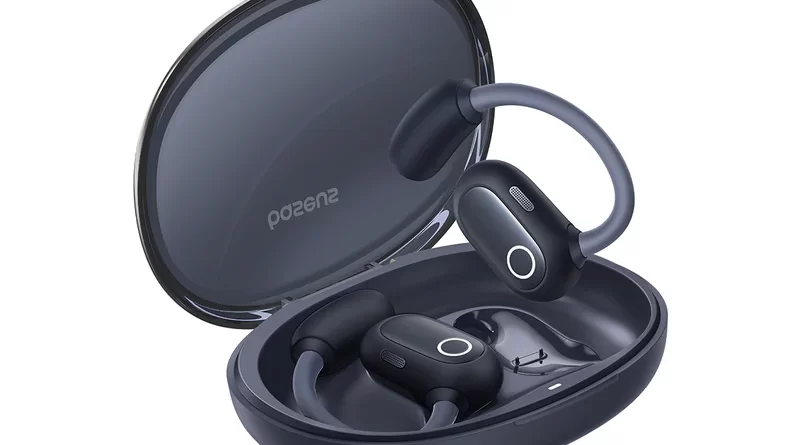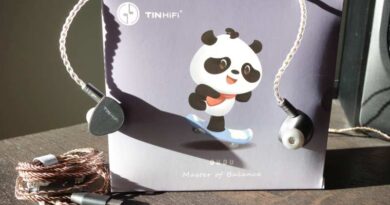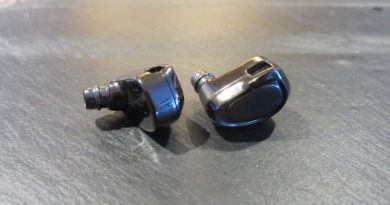Baseus Eli Sport I Review (2) – Off The Mass
An off-the-choir design, an attractive shape, and a modest price. That’s enough to make these “odd” buds a curiosity. Here’s my long overdue report.
In this Article
At-a-glance Card
| PROs | CONs |
| Nice, well balanced tonality | Not audiophile-tier sound quality |
| Superior stage projection (thx to “open ears” fitting) | Could use reshapeable ear hooks |
| Good connectivity | Not very powerful |
| Nice supporting app features | No wear detection |
| Modest price | No ANC |
| No APTX nor LDAC support |
Full Device Card
Test setup
Transports: Samsung smartphone, Sony NW-A55 and WM-1A DAP – 16/24bit-44.1/192KHz and DSD64/128/256 tracks
I am not writing these articles to help manufacturers promote their products, even less I’m expecting or even accepting compensation when I do. I’m writing exclusively to share my fun – and sometimes my disappointment – about gear that I happen to buy, borrow or somehow receive for audition.
Another crucial fact to note is that I have very sided and circumscribed musical tastes: I almost exclusively listen to jazz, and even more particularly to the strains of post bop, modal, hard bop and avantgarde which developed from the late ’50ies to the late ’70ies. In audio-related terms this implies that I mostly listen to musical situations featuring small or even very small groups playing acoustic instruments, on not big stages.
One of the first direct consequences of the above is that you should not expect me to provide broad information about how a certain product fares with many different musical genres. Oppositely, you should always keep in mind that – different gear treating digital and analog sound in different ways – my evaluations may not, in full or in part, be applicable to your preferred musical genre.
Another consequence is that I build my digital library by painstakingly cherry-pick editions offering the least possible compression and pumped loudness, and the most extended dynamic range. This alone, by the way, makes common music streaming services pretty much useless for me, as they offer almost exclusively the polar opposite. And, again by the way, quite a few of the editions in my library are monoaural.
Additionally: my library includes a significant number of unedited, very high sample rate re-digitisations of vinyl or open-reel tape editions, either dating back to the original day or more recently reissued under specialised labels e.g. Blue Note Tone Poet, Music Matters, Esoteric Jp, Analogue Productions, Impulse! Originals, and such. Oppositely, I could ever find an extremely small number of audible (for my preferences) SACD editions.
For my direct and conclusive experience, virtually none of the above is available on the most common streaming platforms, which makes their offering of high sampling material apriori pointless for my purposes. Quite simply, then, I don’t use streaming services as I find them not up to my requested quality.
My source gear is on its turn selected to grant very extended bandwidth, high reconstruction proweness, uncolored amping. Which in particularly means that TWS and any other form of lossless-based wireless gear is apriori off my selection panel.
And finally, my preferred drivers (ear or headphones) are first and foremost supposed to feature solid note-body timbre, and an as magically centered compromise between fine detail, articulated texturing and microdynamics as their designers can possibly achieve.
In terms of presentation, for IEMs I prefer one in the shape of a DF curve, with some very moderate extra pushup in the midbass. Extra sub-bass enhancement is totally optional, and solely welcome if seriously well controlled. Last octave treble is also welcome from whomever is really able to turn that into further spatial drawing upgrade, all others please abstain.
Physicals
Build
Baseus Eli Sport I carry & battery recharge case is quite big and fully plastic. It surely is not built to resist falls or hits. Actual housings seem much more solid instead, and even those big earhooks appear realiably connected to the main body, and offer good confidence into their possible life span.
Fit and Comfort
Eli Sport I follow an uncommon “over ear” design: they are not supposed to plug into the ear canal like IEMs, not to touch (and press onto) neck bones like BC drivers. You just put them on by passing their earhooks over the auricles, and their housings will “sit externally” onto the outer ears, without occluding the canal nor even the concha. actually.
As a consequence they are super easy to fit, and in general very comfortable thanks to their very low weight and the good silicone quality used to sheath the ear hooks. Inside such hooks there are some elastic titanium wires which on one end effectively help ensuring said hooks easily and comfortably adapt to different auricle shapes and sizes, yet on the flip side offer zero shape customisability.
Such latter aspect is quite important (in negative) as depending on their particular auricle shape some user (e.g. me!) will not be able to optimise the driver’s output nozzle position in relation to the concha and one’s one canal entrance, thereby losing a good opportunity to optimise sound quality and SPL delivery. What a pity.
Driver housings being designed to stay “over” the ears, no such things as “tips” or “pads” are necessary on Eli Sport I. You just “lay” them there, and that’s it.
Tapping once on more on the housings allows the user to issue the usual commands e.g. track fwd, track backwards, play, pause, answer call, reject call, etc. Gestures can be customised on the companion Android app.
Last but not least the removable strap is just brilliant. Once installed, it helps avoid losing earpieces while running or even while sitting for e.g. on an airplane. There is even an optional item acting as a neck slider to pull on the earpiece and help them stay putt, for those who prefer such an situation. A rare example of a good idea, well implemented too.
Connectivity and battery
Baseus Eli Sport I support Bluetooth 5.3, but sadly only SBC / AAC codec is supported. No aptX, nor LDAC – forget hi-res audio in the first place. Luckily, at least some sort of LL (Low Latency) is implemented, making using them while watching movies, or for live video calls actually viable. The LL mode can be switched on/off via the Android companion app.
Pairing with all the transports I tried. starting with my phone, was straightforward. Connection holds for approximately the whole 10 meters indicated in the specs. Multihoming is also supported.
The buds themselves turn ON when taken off the battery case, and OFF when put back in. After pairing the two to a given source, they can be used together or one at a time as preferred – just leaving one of the two inside the case. Sadly, wearing on/off gesture (“wear detection”) is not supported: you have to wear them and start playback by tapping, and stop playback and take them off by tapping.
The battery-case has a USB-C port for recharging of course. Clicking on the (almost invisible) button on the case basement you a LED light flashing in different colours telling you more or less how much battery charge is left.
The earpieces have something like 6-8 hours of playback time depending on usage, and the case can fully recharge them for about 3 more times, up to a theoretical autonomy of about 30 hours. Earbuds fully recharge in 1 hour when stored in the case. The case itself requires instead more time (like 2+ hours) but after 10 minutes of recharge it already acquires 2h autonomy. Much more simply put: if every time you take it off you put them back into the charger, Eli Sport I will support you on a single case charge for like 2 days of very heavy (almost continuous) use, or for like a full business week of commuting playback + business calls.
Sound analysis
TWS earphones/headphones/earbuds cannot and of course will no do miracles. Bar very latest iterations, usual BT codecs are lossy, and some of them are loe res too. Their built-in DAC are logically and expectedly much less sophisticated than those incorporated into high quality DAPs or mobile DAC/AMP or dongles. The situation is by definition not on the same page as wired IEMs / cans.
Last and not least in most cases TWS drivers are used to playback streamed tracks from services like Spotify, Tidal etc, which as any real acoustic music fond audiophile knows offer at best “high resolution sampling” tracks, yet referred to sub-best, and sometimes even subpar masters/editions. Curtly put: TWS drivers are by design not for real audiophile use (some hint of improvement is slooooowly coming up from some non-chifi vendor but it’s not fully on the market yet)
Eli Sport I make of course no exception, which is even more obvious if you consider their lack of support for any high-tier BT codec to begin with. With all that said, they don’t sound “bad” at all. Tonality is nice actually, and the graphic Equaliser module on the Android companion app works more than decently. Forget about the preset curves instead, I couldn’t find a single one worth the listen. No matter: just make your own and you’re an happy camper
Due to their “open over ear” design, Eli Sport I of course structurally deliver a “grand” soundstage impression, which is together with their pleasant tonality no doubt the best part of their sound performance. All other technicalities (imaging, layering, microdynamics, detail retrieval) are… basic.
Again do to their external placement on the ear, Eli Sport I of course offer zero noise attenuation while playing back. That’s a precise marketing / intended use choice: listen to music while keeping full awareness of what’s happening around, so that, for example, you don’t risk no to hear a car coming while jogging or sortof.
There is on the other hand supposed to be ANC applied to mic input, aimed at making your voice get across cleaner to the other parties during a phone call. Sadly, it’s not very effective. Indeed, remove “very”. It’s not effective at all. Too bad.
Specifications (declared)
| Housing | ABS+PC+metal+silicone. IPx4 certified. Plastic charging case (not waterproof). |
| Driver(s) | 1 x 15.2mm dynamic driver |
| Connectivity | Bluetooth 5.3 – SBC codec. 60ms latency. 10m range |
| Battery | 7h battery life, 1h recharge time for the buds. 3 full earbuds recharges (600mAh) for the case. |
| Accessories and package | USB-C battery case recharge cable, Detachable necklace |
| MSRP at this post time | € 79,99 on Amazon.it or $69,99 + import cost on manufacturer site |
| Purchase link | https://www.baseus.com/products/eli-sport-1-open-ear-tws-earbuds |
Considerations & conclusions
Baseus Eli Sport I have probably never been intended for audiophile critical listening, and in facts they don’t deliver on that front – which is something I note as I am into audophile sound, while most casual users may rightly not care a single bit about this.
Indeed, take for what they are – casual musical listening tools, with support for business calls – Eli Sport I are a good product. Their uncommon over ear placement design delivers a mix of grand stage impression, environmental immersion, and wear comfort which is sincerely nice, and considering their very modest price this, alone, may justify the purchase.
The Eli Sport I set I assessed have been provided free of charge by Baseus, to whom my thanks go for the consideration and the trust.
Our generic standard disclaimer.







